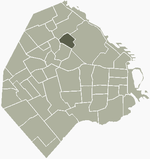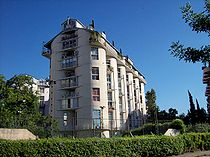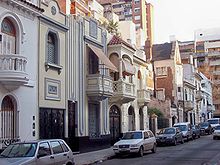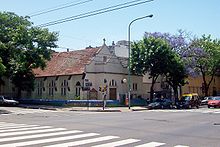- Colegiales
-
Colegiales — Barrio — Federico Lacroze Avenue, the commercial heart of Colegiales Location of Colegiales within Buenos Aires Country  Argentina
ArgentinaAutonomous City Buenos Aires Comuna C13 Area – Total 2.3 km2 (0.9 sq mi) Elevation 25 m (82 ft) Population (2001) – Total 56,998 – Density 24,781.7/km2 (64,184.4/sq mi) Time zone ART (UTC-3) Colegiales is a barrio or district in Buenos Aires, Argentina. It is located between Alvarez Thomas av., Forest av., De los Incas av., Virrey del Pino st., Cabildo av., Jorge Newbery st., Crámer st. and Dorrego av. This neighbourhood offers a vast amount of contrast and opportunities. There are large and tall buildings that go from the Crámer street to Avenida Cabildo and traditional houses up to three stories. This district has become a busy one with lots of pedestrians and cars that go about on the streets. This neighbourhood is mainly residential, with some non-residential areas like the classification yard in the north-east zone, the fairs in the south-west (where until late 60's there was another classification yard) and the UCA grounds in south-east. Some people call the south zone "Palermo Soho" though irrefutably the area belongs to Colegiales, not Palermo.
Contents
History
The history of Colegiales is the same as the barrio of Chacarita because it used to be called Chacarita de los Colegiales. This neighbourhood had chacras and quintas, where the Jesuits had land which they used to take vacations along with their students. When this religious people where expelled in 1767, the lands were expropriated by the Spanish Crown. Later during the government of Rivadavia, in a time of gold, workers and immigrants from Europe settled in the area thereby creating the two neighbourhoods of Chacarita and Colegiales.
Sports
In this district the Club Atlético Colegiales developed, a football club that plays in the Metropolitan 4th division of Argentine football. Today, however, it is in the city of Munro, north of Buenos Aires.
Tourism
Colegiales is one of Buenos Aires' smallest districts. Its main thoroughfare is Federico Lacroze avenue, where most neighborhood traffic and retail stores are concentrated. Alvarez Thomas avenue is a study in contrasts, lined with single-family rowhouses along one side and almost entirely with apartment blocks along the other. The avenue also separates Colegiales with its neighbor to the south, the barrio of Chacarita.
The Pasaje General Paz (an "alley" or narrow street only for pedestrians) attracts visitors near and far, with its mature trees, bridgepath streams and ornate, balconied Andalusian-style patio. Colegiales is also one of the city's "greenest" areas, being also home to Juan José Paso Plaza, Portugal Plaza, San Miguel de Garicoits Plaza, Colegiales Plaza and Mafalda Plaza -known for its whimsical art donated to it by renown local cartoonist Joaquin Lavado ("Quino")-.
Social and cultural life
The Colegiales Athletic and Social Club is probably the neighborhood's favorite social venue. Located on 2860 Teodoro García Street, it was famous in decades past for Roberto "Polaco" Goyeneche's frequent Tango recitals there. Colegiales was also home to the city's first cinema, "Las Familias." The cinema was probably better-known, however, for the people who had it built than for its distinction as a historical first. Though now a distant memory, the colorful Anselmis entertained generations of locals with their namesake circus on Lacroze and Cabildo Avenues.
The Argos Cinema (on 3455 Federico Lacroze Ave.) was long the most popular in Colegiales, however, as it had included a cinema, theatre, meeting hall (popular with evangelists) and a dance hall. Today, sadly, none of these establishments exist, as they either shut down or relocated to the more upscale Belgrano, to the east.
Its cafés, many still open, are often not unlike pool halls, frequented by night owls and assorted "ne'er-do-wells". Perhaps the best-known is the Argos Café (Federico Lacroze & Alvarez Thomas Avenues), which still boasts its period decor and billiard tables.
The Federico Lacroze Area Development Council, on 3955 Maure Street, publishes its own periodical, El Fomentista. Socially and culturally invested, it provides a forum for literary circles like the Enrique Banchs Literary Society and the Chacarita-Colegiales Historical Society. Colegiales is also home to a Rotary Club, on Arribeños & José Hernández Streets and a Lions Club, on 2964 Teodoro García St.
Recently, upscale lofts were developed in what years ago were the massive Buenos Aires flour mills (known also as "Silos Minetti), on 1916 Dorrego Street. Elegant and trendy, they were built into the silos themselves (see photo above) and have become popular with local "yuppies."
Until 1988, the popular Dorrego Farmers' Market operated in Colegiales, on Alvarez Thomas & Dorrego Avenues. Its stalls were run by a veritable "United Nations" of Portuguese, Italian, Spanish and Japanese-Argentines and offered all manner of produce and homemade canned goods. It later became Buenos Aires' largest flea market, famous for its supply of everything from African handicrafts to antique china, costumes and housewares.
Religious heritage
Colegiales also has a rich religious heritage. The Holiest Corpus Christi Monastery (450 Amenábar St.) has been the centuries-old home to the Order of "Barefoot Carmelites". Likewise, the Church of St. Paul the Apostle (795 Alvarez Thomas Ave.) and the Parish of Our Lord of the Miracle of Salta (1157 Moldes St.) still draw a sizable flock. These houses of worship share the Colegiales faithful with several smaller Catholic churches and others, notably the Evangelical Church of Colegiales, at 3429 Federico Lacroze Avenue.
References
- (Spanish) Barrios Porteños
Barrios of Buenos Aires 
Agronomía · Almagro · Balvanera · Barracas · Belgrano · Boedo · Caballito · Chacarita · Coghlan · Colegiales · Constitución · Flores · Floresta · La Boca · La Paternal · Liniers · Mataderos · Monte Castro · Monserrat · Nueva Pompeya · Núñez · Palermo · Parque Avellaneda · Parque Chacabuco · Parque Chas · Parque Patricios · Puerto Madero · Recoleta · Retiro · Saavedra · San Cristóbal · San Nicolás · San Telmo · Vélez Sársfield · Versalles · Villa Crespo · Villa del Parque · Villa Devoto · Villa Lugano · Villa Luro · Villa Mitre · Villa Ortúzar · Villa Pueyrredón · Villa Real · Villa Riachuelo · Villa Santa Rita · Villa Soldati · Villa Urquiza
Landmarks of Buenos Aires Note: "Buenos Aires" denotes the city of Buenos Aires proper, not the entire Greater Buenos Aires metropolitan area.Public
& historic buildings
and structuresArgentine Congress · Torre Monumental · Cabildo · Café Tortoni · Casa Rosada · Central Post Office · City Hall · City Legislature · Customs House · Duhau Palace · Estrugamou Building · Floralis Genérica · Galerías Pacífico · Hotel de Inmigrantes · Kavanagh building · Libertador Building · Metropolitan Cathedral · Monument to Giuseppe Garibaldi · Obelisk of Buenos Aires · Palacio Barolo · May Pyramid · Pizzurno Palace · Plaza Hotel · Recoleta Cemetery · San Martín Palace · Sarmiento Frigate · Uruguay Corvette · The Water Company Palace · Women's BridgePrecincts
& neighbourhoodsAlmagro · Belgrano · Buenos Aires CBD · Caballito · City Centre · Colegiales · Montserrat · Núñez · Palermo · Puerto Madero · Recoleta · Retiro · San TelmoNature and parks Avellaneda Park · Botanical gardens · Buenos Aires Ecological Reserve · Chacabuco Park · Congressional Plaza · Japanese Gardens · Lezama Park · Palermo gardens · Plaza de la República · Plaza de Mayo · Plaza San Martín · Parque Centenario · Buenos Aires ZooCultural
InstitutionsEl Ateneo Bookstore · Argentine Automobile Club · Bernardino Rivadavia Natural Sciences Museum · Buenos Aires Museum of Modern Art · Café Tortoni · Fortabat Art Collection · House of Culture · Illuminated Block · Isaac Fernández Blanco Museum · King Fahd Cultural Center · Latin American Art Museum · Museum of Foreign Debt · National Library · National Museum of Decorative Arts · National Museum of Fine Arts · National Museum of History · Opera House · Paz Palace · Planetarium · Recoleta Cultural Center · San Martín Cultural Center · San Martín National Institute · Sarmiento Museum · Eduardo Sívori MuseumSport Bombonera Stadium · River Plate Stadium · Ducó Stadium · Maradona Stadium · Vélez Sársfield Stadium · Argentine Hippodrome of Palermo · Lawn Tennis Club · Polo Stadium · Race Circuit · Arena Obras Sanitarias · CeNARD · Estadio Ricardo EtcheverryTransportation Shopping
& entertainmentAbasto Mall · Avenida Theatre · Cervantes Theatre · Fishermen's Pier · Galerías Pacífico · Gran Rex Theatre · Luna Park Arena · Paseo La Plaza · Patio Bullrich · Opera Theatre · Parque de la Ciudad · La Trastienda ClubStreets
& avenues9 de Julio Avenue · Avenida Alvear · Avenida de Mayo · Avenida del Libertador · Callao Avenue · Caminito · Córdoba Avenue · Coronel Díaz Street · Corrientes Avenue · Figueroa Alcorta Avenue · Florida Street · General Paz Avenue · Leandro Alem Avenue · President Roque Sáenz Peña Avenue · Rivadavia Avenue · Santa Fe Avenue · Scalabrini Ortiz AvenueCoordinates: 34°34′27″S 58°26′57″W / 34.57417°S 58.44917°W
Categories:- Neighbourhoods of Buenos Aires
Wikimedia Foundation. 2010.





